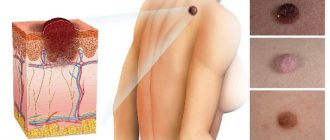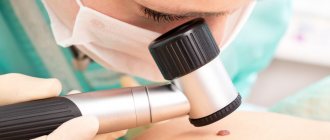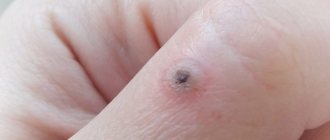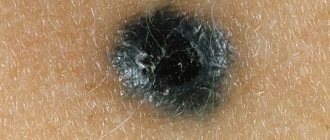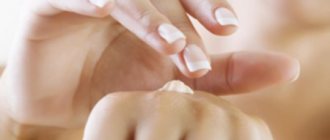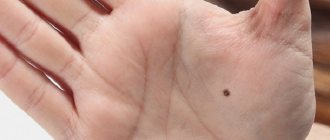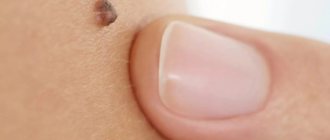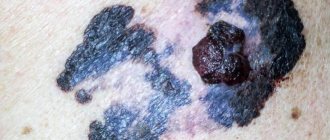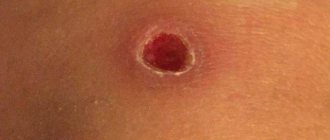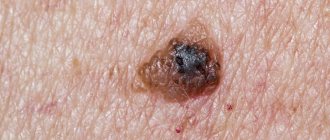Almost all people have moles. They appear when there is an excess accumulation of melanin in skin cells. In most cases they are benign and do not change over time.
But not everyone knows what to do if a mole becomes inflamed. This fact cannot be ignored. After all, symptoms may indicate the development of pathological processes that are very dangerous. It is necessary to promptly consult a doctor who will make the correct diagnosis.
Alarming changes
Moles can be located on any part of the body; they are not always visible. Therefore, a person may not immediately notice the metamorphosis of any formation on the skin.
What changes in the appearance of a mole should alert you? Warning symptoms include:
- redness of the mole and the skin around it;
- itching and burning;
- swelling, change in color, shape and size of the spot;
- blurring of contours;
- formation of a tubercle or pustule;
- the appearance of crusts and cracks;
- bleeding.
The listed signs may indicate the beginning of the process of transition of a mole to melanoma - skin cancer. Therefore, there is no need to hesitate and put off visiting a doctor. Timely measures taken can save health and life.
If the mole is inflamed and reddened
Almost always, inflammation of a mole is not malignant; it is often a purely dermatological problem.
Since the mole itself on the skin is located above the level of the hair follicles and sebaceous glands, inflammation can begin in them, and the excretory duct simply passes through the mole. Outwardly it looks like a pimple.
There are many reasons – from microtraumas and pollution to failures in the body’s metabolic processes.
Malignant degeneration of the skin, the so-called melanoma, is dangerous as it develops very quickly. But with early detection of the first signs of the disease, it is successfully treated. Therefore, when the first alarm bells appear (redness, itching, white eagle, change in shape, etc.), you should immediately go to the doctor.
For more information about irritations in the mole area, watch our video:
Causes of inflammation of moles
Modification of birthmarks does not occur without good reason. Inflammation is promoted by:
- Prolonged exposure to sunlight, sunburn, and ultraviolet radiation in a solarium lead to changes in the structure and damage to the integrity of epidermal cells. This causes redness and irritation. The skin begins to peel, flake off, and along with it the burned mole may fall off.
- Mechanical damage to the nevus (scratching, cutting, blow) provokes infection and pathogens. A pimple or boil may appear in the mole area.
- Chemical exposure to household chemicals, an allergic reaction to cosmetics, acid or alkaline burns damage the skin and cause irritation. The mole may become covered with a light coating and acquire a fuzzy outline.
- The development of skin diseases, dermatitis, and fungal diseases leads not only to infection of the vulnerable tissues of the birthmark, but also to pain symptoms.
- If a mole becomes inflamed, it may indicate development into melanoma. This formation leads to a disorderly proliferation of healthy skin cells and requires medical supervision.
The causes of inflammation can be different: harmless and easily curable, or serious and requiring complex therapy. To make an accurate diagnosis and prevent serious consequences, you should seek qualified medical help.
Causes of red nevus
A mole is a neoplasm of a benign nature. Can be located anywhere on the skin. As a rule, it does not cause any particular discomfort.
However, sometimes a person discovers that a mole has become inflamed. Why is this happening? What can trigger inflammation? Experts identify several main reasons.
Causes:
- Oncology,
- Rebirth,
- Irritation,
- Pathological changes.
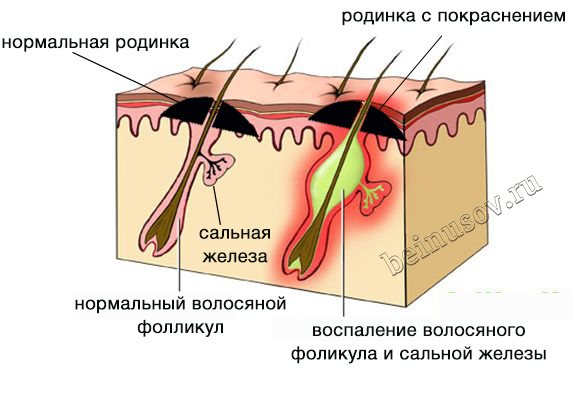
Such factors should be considered in more detail.
Oncology
As a result of the accumulation of melanocytes in the skin, moles are formed. Each of us has them. Basically, these neoplasms are benign and do not change during a person’s life.
If moles become inflamed or any changes occur in them, you need to be wary, as this may indicate the beginning of their degeneration.
Where do moles come from?
The reasons for the appearance of birthmarks on the body are as follows:
- genetic predisposition. The number of moles and their location can be inherited from parents to children;
- hormonal disorders. Most often, moles appear in teenagers, pregnant women, during menopause, after stress or certain diseases. The reason is a change in the level of hormones in the blood;
- influence of the sun. With prolonged exposure to ultraviolet rays on the skin, increased production of melanin occurs, and this provokes the appearance of tumors;
- skin trauma. Frequent trauma to the skin can lead to the appearance of birthmarks.
Why does redness appear after injury?
Folk remedies
In some cases, an inflamed birthmark can be treated using home remedies.
- To get rid of redness, it is recommended to treat the inflamed area with alcohol or alcohol-containing lotions and make lotions from them. For example, tinctures of calendula, echinacea or propolis effectively fight inflammation, remove pustular formations and heal wounds.
- If the birthmark has darkened, and this is not caused by any disease, a solution of salicylic acid or diluted lemon juice will help lighten it. In addition, these remedies will relieve the inflammatory process. The salicylic acid solution should be applied with a cotton swab 1-2 times a day. Frequent use dries the skin, so you should not get carried away with this method. To avoid allergies, it is better to dilute lemon juice with boiled water in a 1:1 ratio. After 1-2 weeks of using such solutions, the stain should lighten.
- If a mole is inflamed in a sensitive area of the body, then it can be treated with herbal compresses. To do this, prepare a strong decoction of chamomile, thyme or St. John's wort. Pour two tablespoons of plant material into a glass of boiling water and keep in a water bath for 10 minutes. After cooling, the broth should be cooled. A piece of gauze or a handkerchief is soaked in the liquid and applied as a compress to the inflammation 3-4 times a day for 15-20 minutes.
- If the mole is swollen and inflated, this may indicate an internal subcutaneous boil. A warm cabbage leaf will draw out the pus from the tissues. To make a compress, you need to mash the leaf with a rolling pin and scald it with boiling water. While the sheet has not cooled, apply it to the inflamed area and cover with polyethylene. Keep for 20-30 minutes.
- If a pimple occurs on a birthmark, the products that are in every home medicine cabinet will help: Streptocide, antibacterial or zinc-containing ointment. Their antiseptic properties will cope with suppuration. Ointments are applied according to the attached instructions, and Streptocide is applied to the damage in powder form. To do this, just crush 1 tablet and sprinkle on the abscess.
- For injuries, cuts and other tissue damage, it is necessary to treat the birthmark with an antibacterial agent. An effective antiseptic is Furacilin solution. It is also good to use if the mole is festering. To prepare it, you need to dissolve 1-2 tablets in 100-150 ml of warm water. The resulting mixture should be washed off the affected area.
Other dangerous symptoms
If a person has an inflamed mole, it is impossible not to notice. There are certain symptoms that accompany this situation.
Signs:
- Lack of symmetry. In the normal state, the formation has a symmetrical shape. If the shape changes or one side of the mole enlarges, you must contact a medical facility.
- Contours. A birthmark always has clear boundaries. If it begins to blur, this may indicate a possible inflammatory process.
- Color change. As a rule, throughout the entire period of presence of a mole on the body, its color remains constant. When inflamed, the nevus becomes darker. If the mole is simply rubbed, then redness is noted.
- A sharp change in the size of the formation indicates its inflammation.
- Any change noticeable externally should alert the patient. The appearance of purulent (becomes like a pimple) or bloody discharge, pain, microcracks, itching - these signs should make a person worry about his condition.
READ MORE: What happens if you pick off a mole
Any inflammatory process is accompanied by various signs. It is necessary to monitor nevi and note every change.
In addition to the redness of the mole, additional symptoms are often present:
- the mole is swollen and has uneven, unclear boundaries;
- the shape has changed and become asymmetrical;
- the shade of education has become different;
- size increased;
- the area near the formation is swollen;
- there is itching and pain when touched.
Precautionary measures
It is important to remember that home treatment is only permissible if serious diseases are excluded and after the approval of a doctor. Some symptoms are particularly dangerous and do not allow for independent manipulation. .
- If a mole has crusted over, you should under no circumstances try to get rid of it. This can cause bleeding, contamination and infection not only in the tissue but also in the blood. Perhaps its appearance is caused by dry skin and after some time it will fall off on its own.
- A nevus can change color and become completely black. There is no need to rush to lighten it. It was probably damaged and there was simply blood clotted in the tissues. But it is possible that the spot goes into the stage of malignant formation.
- A mole bleeds if it is mechanically damaged. If you cut or scratch, you should immediately disinfect the injured area and apply a bandage. Then you need to carefully monitor so that the nevus does not fester and start bleeding again. For any changes, a doctor's examination is required.
- If a hanging mole has dried out or fallen off, it is necessary to conduct histology of the dead tissue. Sometimes the cause is hormonal changes and disruptions. But perhaps the spot is degenerating into melanoma.
Mole removal
If the prescribed drug treatment or the use of folk remedies does not produce the desired results, and the birthmark is not a malignant formation, the doctor prescribes its removal. The procedure is performed using a laser, radio knife or surgical scalpel.
The choice of method depends on the location of the mole, its size, the condition of the skin, taking into account all contraindications. Before the operation, you need to undergo an examination, dermatoscopy, and a series of tests to exclude complications and unforeseen consequences.
Compaction of the formation and increase in size is often a symptom of a malignant tumor. A biopsy is often used to clarify the diagnosis. If cancer cells are detected, a course of chemotherapy and radiation is prescribed, which prevents the tumor from growing and prevents the disease from spreading to internal organs.
Whatever the cause of the inflammation, if there are any changes in the birthmark, you should immediately see a doctor. He will prescribe the necessary examination and select a course of treatment, which consists of using ointments and taking antibiotics. Ignoring modifications and letting the process take its course is not the best solution. After all, not only health, but also life can be at stake.
Self-medication methods
Inflammation therapy is carried out in a medical facility. First of all, a diagnosis is established using various studies. The treatment method is chosen only by the doctor after making a diagnosis.
Therapy:
- If there is no threat to health, inflammation is treated with external agents - ointments, creams, gels. It is better if the drug contains zinc or salicylic acid. Streptocide powder helps a lot. It is possible to use products containing an antibiotic to eliminate inflammation and the spread of bacteria. This therapy can be carried out at home.
- Delete. This technique is used in the absence of results from other treatments and in case of detection of the presence of malignant cells. To perform the operation, permission from the oncologist is required. The procedure is performed in a hospital under local anesthesia. The removed tumor is sent for histological examination. The operation lasts no more than half an hour, and the patient can go home almost immediately. (find out whether it is possible to remove moles at all)
What to do at home if a birthmark becomes inflamed and there is no way to see a doctor right away? In this case, the inflammation can be treated with medical alcohol and calendula tincture. Freshly squeezed aloe, lemon or garlic juice has an excellent effect. It is worth remembering that these are temporary measures; you definitely need to visit a specialist.
If during the postoperative period the patient's scar becomes inflamed, then it is necessary to contact a medical facility. It is possible that an infection was introduced during the removal process. In this case, measures will be taken to relieve the inflammatory process and accelerate wound healing.
The doctor selects the treatment method depending on the form, stage and severity of the disease. In some situations, the use of topical anti-inflammatory drugs is sufficient to eliminate unpleasant signs of the disease. A biopsy may be required to determine the correct diagnosis.
However, many doctors do not approve of this research technique, since with additional damage to the inflamed mole, its condition may change for the worse. When examining reddened nevi, dermatoscopy or computer diagnostics are performed.
READ MORE: Large mole on the back is convex
